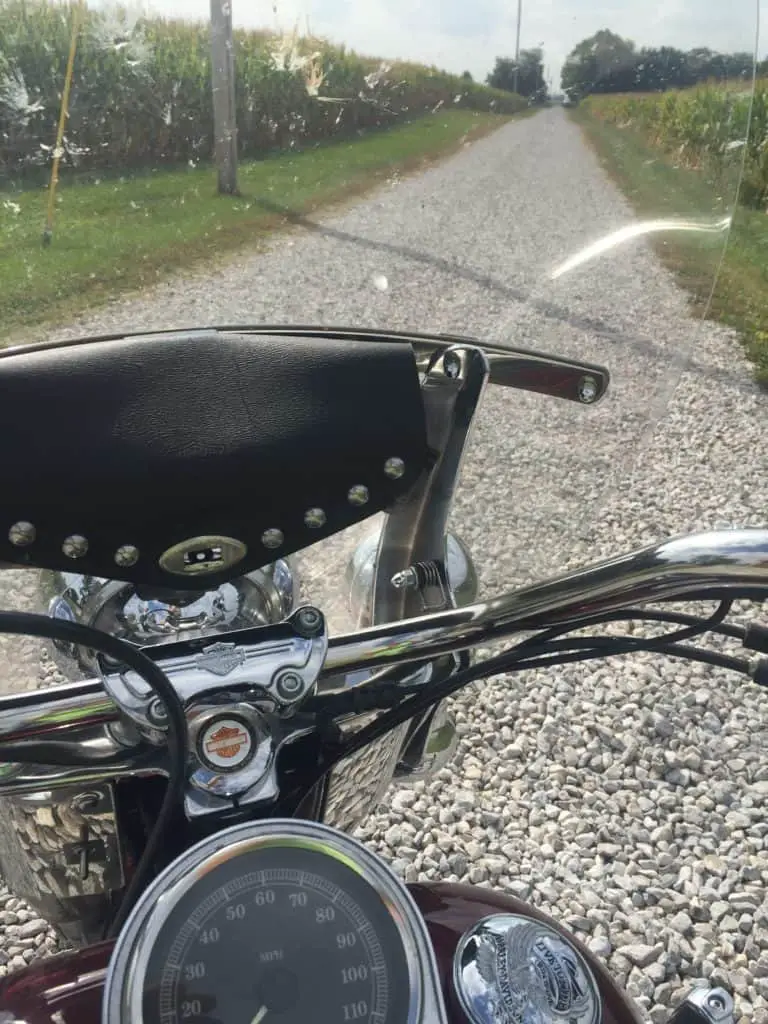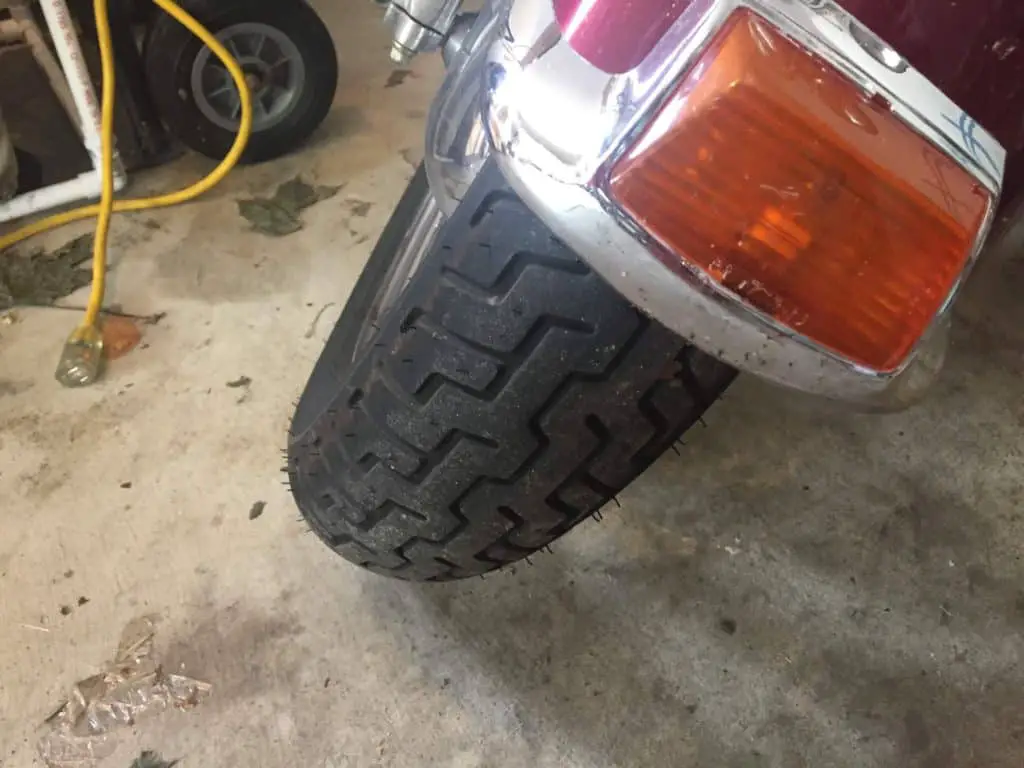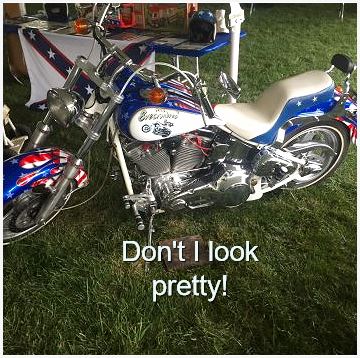
Last fall I took a ride on my Harley that went from the pavement to off-road riding on gravel and dirt roads. I never thought my motorcycle cruiser would travel off-road for many miles. Now I wonder how far off-road you can take a cruiser motorcycle.
Can you ride a motorcycle cruiser off-road? Yes, you can ride a motorcycle cruiser off-road. The rider will be most comfortable and safer on dirt roads, compact gravel roads, and fire roads. Cruiser motorcycles will have a hard time navigating single track trails and riding in the woods, sand, and mud.
Just how far you can take a cruiser off-road depends on many factors, and the skill level of the rider. Before you take your cruiser off-road, consider the following.
How Terrain Affects Taking Your Cruiser Off-road
Where do you plan on riding your motorcycle cruiser? My first real encounter came by accident. One of my favorite rides involves visiting covered bridges. Most of them are out in the country. I expect to encounter loose gravel on the shoulder, rough roads, no shoulders, and pothole lots and lots of potholes.
What I did not expect was the pavement to end abruptly and to lose the nice riding surface. I wanted to get to two bridges in particular and had to navigate the steep hills to see them. The ride required adapting my dirt bike skills I learned as a kid for the cruiser. The biggest challenge was not being able to stand up to shift weight around on the bike for better traction.
The point is, they do not design cruisers for off-road or spending much time off the pavement without lots of modification. Search the web for Harley or cruiser off-road and you will find stories, pictures, and videos of highly modified motorcycles.
For the average rider, taking your cruiser off-road brings lots of surprises, scratches, and dents. I am still cleaning from my unexpected trip off-road.
When you think you might have a chance of going off-road study the landscape using the following points:
- Pull up a topographical map and see what the elevation changes look like. If you have ridden the same general area but on pavement, take time to recall what the elevation change was like. Was it hilly, if so were they steep?
- Was there coverage on the roads or trees along the side of the road? This plays an important role when riding off-road covered in shadows or leaves in the fall. When riding earlier in the day, know the ground will take longer to dry since the sun will not be shining on it.
- What is the surface of the trail, or road you will ride? Riding in mud, gravel, and sand all require different skills. Know that you may need to brush up on them before you get there.
Selecting An Off-road Tire For Your Cruiser
Opinions vary on the best tire. While we do not have to agree, we are all on the same page knowing cruiser tires belong on the road.
These tires perform poorly when taken off-road. On the ride I mentioned earlier, I had a few scares partly because of the tires on the motorcycle. Mind you, these tires were new with less than 500 miles on them. The other part was because my riding skills were not polished.
Why did the tires scare me? The road leading up to the bridges were loose gravel covered in wet recently fallen leaves. In this situation you need a tire digging through the leaves and pass the top level of loose gravel. Once you get past these two layers, the bike can gain traction. My street tires could spin all day long but lacked the digging action.
Getting to the right amount of traction was tricky. What should you do if an off-road trip on your cruiser is in the future?
Current Tires
First look at your current tires. How worn are they?
Look the tire wear indicators. They will be the little parts of tread that go perpendicular to the tread pattern.

Notice how much tread depth there is on the tire in the photo versus the wear bar. As your tread depth shrinks, the tire has a harder time grabbing onto loose surfaces like dirt and loose gravel. Forget about digging through anything.
Make sure your tread depth is much greater than the wear bars which is the minimum legal depth for a tire. Your tread depth should be at least 3-4 times greater than the wear bar for riding off-road on loose surfaces like dirt and gravel roads.
Forget about trail riding on street tires.
Replacing Your Tires
When you plan on taking the irregular trip off-road on dirt and gravel roads, look at adventure motorcycle tires.
Pure adventure tires look more like dirt bike tires than street tires. However, it is not an all or none trade off. As a rider, you need to consider how much you will be off-road.
For the irregular off-road trip you might consider a tire designed 90% for street use and 10% dirt. These tires will look virtually identical to an all street tire.
For the more aggressive off-road cruiser, you might get a tire for 70% street and 30% off-road.
Adventure Tire Trade-Offs For Your Cruiser Motorcycle
The more dirt preference you have on the tire, the quicker it wears out from road use.
Be realistic about how much will ride off-road. As I looked into taking my Harley off-road, I realized you put the bike and yourself into situations you may not handle.
Specifically, I would speculate the soft suspension of a cruiser do not ride well on adventure tires.
Make sure you consider all the trade-offs before mounting new adventure rubber on your cruiser motorcycle.
Adventure tires are noisy compared to a strictly street tire. The noise gets annoying after a while. Although some will get use to it.
Adjusting Tire Pressure To Take Your Cruiser Off-road
Tire pressure can be your best friend or mortal enemy. When taking your cruiser off-road, make sure you take the time to make the proper adjustments. This means knowing when the road stops.
Why make any change to your motorcycle tire pressure?
If you drive any time at all, you end up with a flat tire. Think back to that the moment you saw the tire. You noticed the part of the tire on the ground is much wider than the rest of the tire. Effectively there is more tire in contact with the road.
When you make an adjustment to your tire pressure for off-road riding, you create the same effect. By lowering, not completely deflating the pressure, you create a bigger contact patch between your tire and the riding surface. The result? More traction.
Opinions vary on how much pressure you should run in your tires but here a table with ranges to get you started.
| Riding Surface | PSI |
| Pavement | Manufacture Recommendation |
| Sand | 8 to 14 PSI |
| Mud | 10%-20% lower than normal |
| Snow | 8 to 14 PSI |
| Gravel | 10% lower than normal |
No Change In Tire Pressure
This would not be a good post without discussing what some experts say. I only came across this information by accident. It was a podcast with an interview of a tire expert on Adventure Rider Radio.
He claimed we should never change tire pressure from the manufacturer’s specifications. This surprised me. Everyone else in the motorcycle community agrees on lowering tire pressure when riding on the surfaces listed above. The difference is in the reduction amount.
The expert clarified his point. They make tires for different conditions and as the rider is it your responsibility to pick the right tire. When riding mainly in mud, get a mud tire. The manufacture puts the PSI ranges on the tire for the best performance and highest level of safety.
This makes sense, but when you may unexpectedly end up off-road, someone may need to change their tire pressure. Before you make any change, make sure you have a way to get the pressure back up before heading back onto the pavement. I have found the XXXXXXXXXX tool at XXXXX to be the best and most reliable way to inflate tires while riding.
Know The Limits Of Your Bike
The notion I could turn my Harley into an off-road machine came from watching World War Two videos of soldiers training for the war. They were riding these things as if they were dirt bikes.
After doing more research, I found many police programs with off-road riding as part if their training. My conclusion at that moment. A Harley is a big dirt bike, you just need to know how to handle it.
Well, the real world does not work like this. We set up modern cruisers for comfort and the road. As I stated before, they have street tires, and soft suspensions. Most have pegs or floorboards in the wrong place.
Attack Position On A Cruiser
The biggest factor preventing cruisers from venturing off-road is the attack position. This position has you standing on the pegs with your knees and elbows bent.
You can through your weight around on the bike to increase traction, position yourself for a corner, and absorb bumps.
The attack position is not possible or difficult to execute for the average daily rider on a cruiser.
Pretty Factor Goes Away When Riding A Motorcycle Off-road
When you find yourself ready to take your cruiser off-road, know you will get scratches, dings, and dirt all over your bike.
These reduce the pretty factor that most people like to maintain with their cruiser.

However, when every ding and scrape is a story, ride on my friend and find that next mud hole. Please do so knowing your own limits as a rider.
Know Your Riding Limits
I watched a video recently about a rider who stated that going fast on a motorcycle was 80% rider and 20% machine. To illustrate the point, he bought an old ragged out endure bike from the 70’s for a few hundred bucks and raced the darn thing.
I do not remember what place he got, but he did really well. The point is your riding skills will be the biggest factor in determining how far or how your off-road adventure goes riding a cruiser.
In the same way over 75% of people think they are good drivers, most riders overestimate their skill level. Ride within your ability.
Here are a few suggestions or skills to master before you even consider taking your cruiser off-road.
- Make sure your balance is strong on the motorcycle. Can you ride slowly with the handlebars turned all the way in one direction around a turn without putting your feet down? No? You are not ready to ride off-road.
- Have you mastered the friction zone of your bike? No? Don’t know what it is? You’re not ready for off-road riding.
- Feel uncomfortable riding in wet grass or loose gravel? Yes? You’re not ready.
RELATED QUESTIONS:
What depth are wear bars on motorcycle tires? The wear bars on motorcycles are at 2/32s which is the minimum legal limit for tires. Replace your motorcycle tires when they get to 3/32 or 4/32s. This will differ from your car tires. Motorcycle tires wear quicker.
